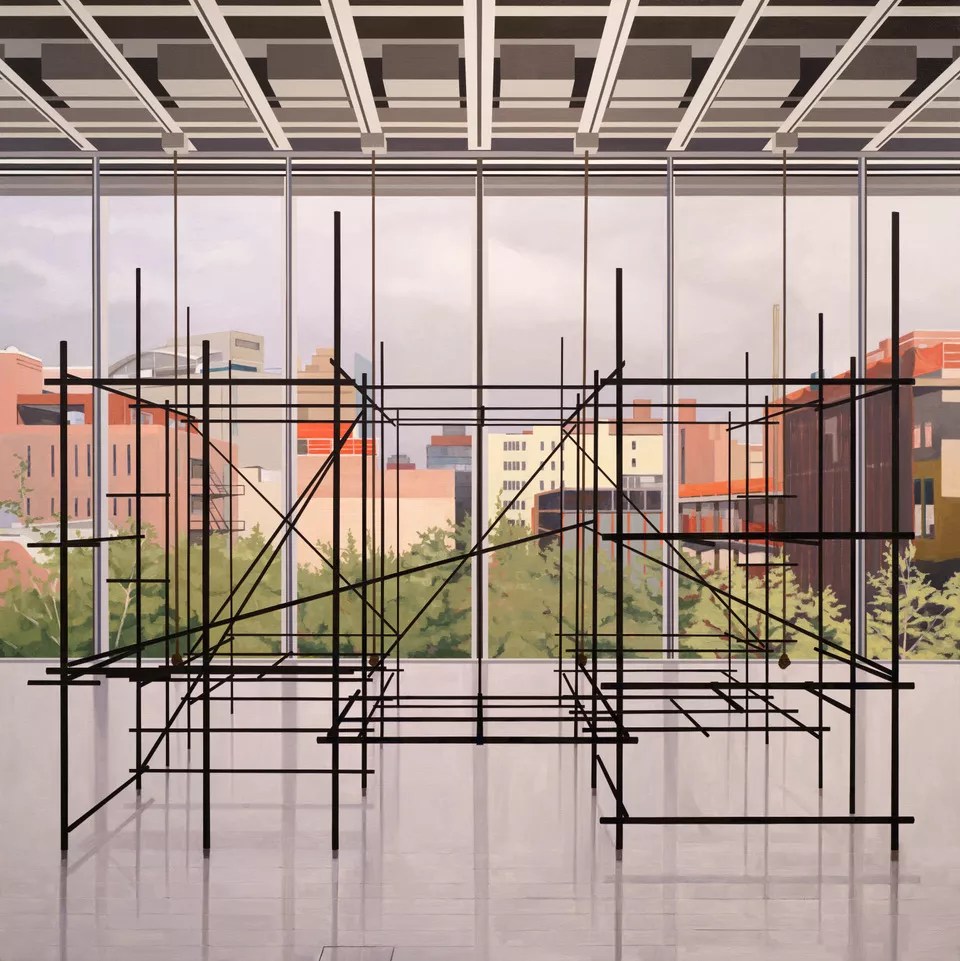
Sarah McKenzie

Audio By Carbonatix
Boulder-based artist Sarah McKenzie paints architecture. She started with canvases of abandoned buildings in the city of Detroit in graduate school, then painted suburban sprawl on the Front Range and construction sites after moving to Colorado. Most recently, with the representation of the David B. Smith Gallery in Denver, she has exhibited works portraying the institutional spaces of galleries and museums – with those paintings often showcased in the very spaces she’s depicting.
“I really think about architecture as a lens through which we can understand our society,” McKenzie says. “If we look at what our society builds and what happens to those built structures over time, it reveals a lot about shifts in our society, our economy, our labor force and our priorities as a country.”
As she considered other types of institutions critical to understanding modern society, she settled on studying the architecture of American prisons. “I thought about prisons as occupying the other end of the social spectrum from the museum,” she says.
In March 2020, she applied to the Marion International Fellowship for the Visual and Performing Arts at the State University of New York at Fredonia. The Marion Fellowship is unique among artistic fellowships in that it supports an artistic journey rather than a concrete project or final product; over the course of a year, it sponsors an artist in visiting four institutions, where they participate in lectures, seminars and themed conferences that stimulate thinking on particular topics. McKenzie became a finalist for the fellowship – and then the pandemic struck, and the Marion Fellowship was canceled for the year.
But the cancellation of the fellowship was a blessing in disguise. McKenzie spent lockdown doing more research into the carceral system and spoke with people active in the criminal justice reform space. They emphasized to her that it was impossible to do work on the architecture of prisons without working closely with those most impacted by the criminal justice system. This helped reorient McKenzie’s focus, and when she reapplied for the Marion Fellowship in 2021, she won it with her revised project, “To See Inside: Understanding the People and Architecture of the US Prison System.”
“It really changed the project for me. It’s still partly about understanding the architecture, but it’s also really understanding the people impacted by that architecture,” McKenzie explains.
Currently, McKenzie is focused on more thoroughly understanding the history of the American prison system and examining the more recent prison abolition movement. Some of the books on her stack include Jackie Wang’s Carceral Capitalism, Michel Foucault’s Discipline and Punish, and Michelle Alexander’s The New Jim Crow. She has also been listening to the Ear Hustle podcast; the With(In) podcast from the DU Prison Arts Initiative; and Motus Theater’s JustUs Monologues. And she is meeting with architects who work in the “justice sector” to understand what kinds of reform efforts exist in that field. Finally, she hopes to visit the Eastern State Penitentiary – which was built in the 1800s and is now a museum – and Alcatraz. Those sites will give her points of historical comparison when she considers the prison system as it exists today.
McKenzie’s fellowship year will consist of a one-week residency at the Chautauqua Institution in upstate New York centered around the theme of building a culture of empathy, a two-week residency at Ucross in Wyoming emphasizing studio practice, and visits to Fredonia and the Alberta University of the Arts in Canada.
“I’m interested in possibly doing some collaborative work with currently or formerly incarcerated artists. But I’m so early in this process that I don’t quite know what that’s going to look like on the other end,” McKenzie says.
Right now, she’s teaching a visual arts course with the DU Prison Arts Initiative, which she views as very much part of her artistic practice for her current project.
“The biggest issue for me is: How does institutional architecture function as a form of social control?” she explains. “That’s the big question that I think of as driving my work at this point in time. Architecture becomes invisible. It’s something that, as we move through it, we’re physically reacting to it and we’re shaped by it, but we don’t even realize it. … Architecture often becomes neutral, but of course, it’s not neutral at all.”
Speaking to her project on prison architecture, McKenzie admits that “it does feel like a departure” from her prior work. “It’s both consistent with it and a big shift, too – which is super exciting,” she says. “I’m basically mid-career at this point, so it’s an amazing opportunity that this fellowship has given me.”